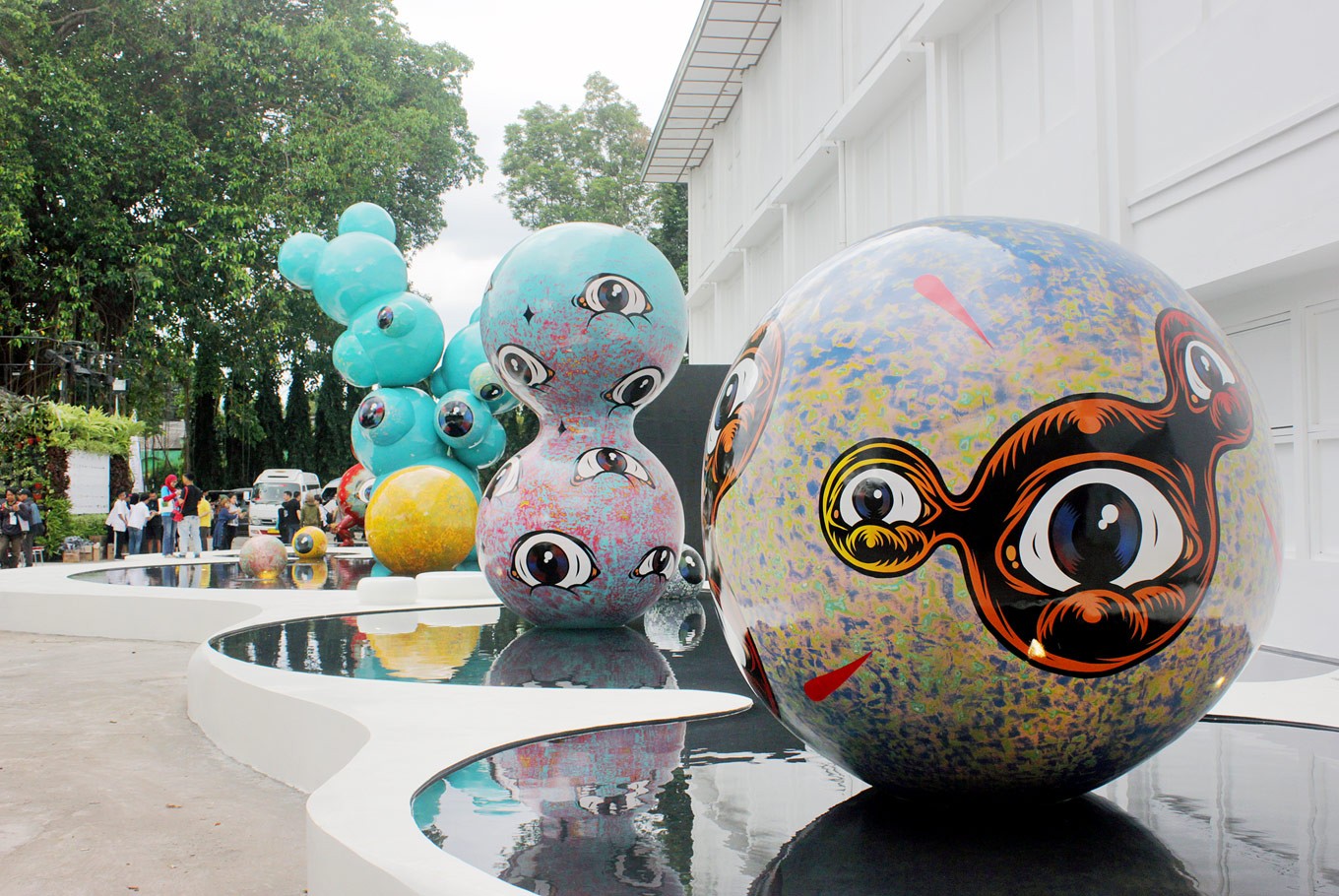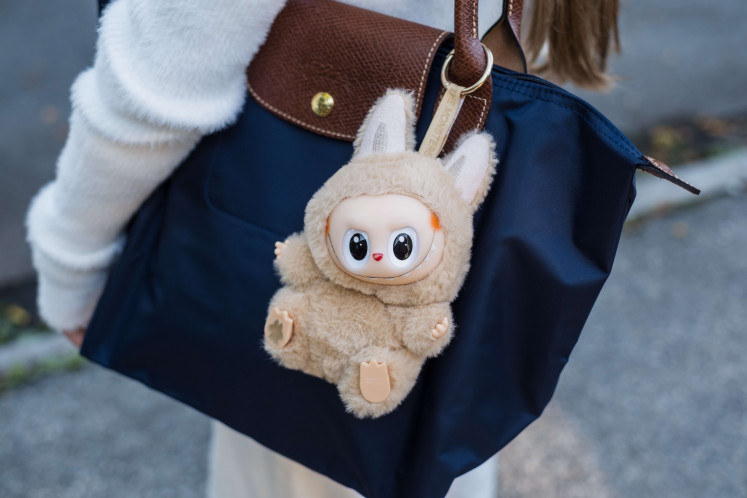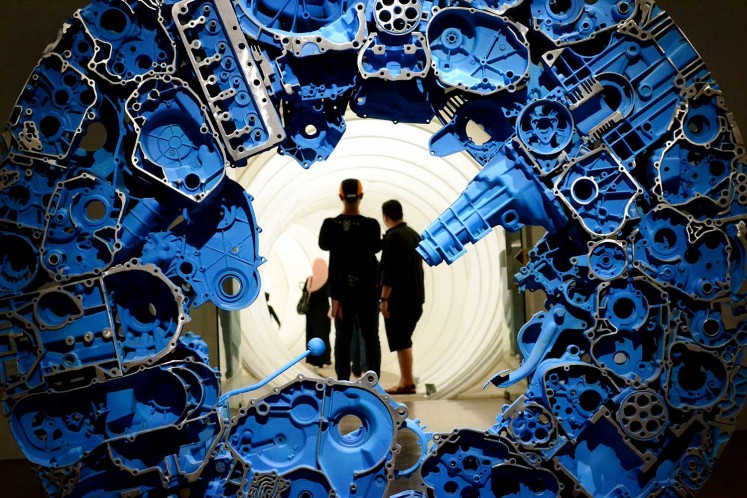Popular Reads
Top Results
Can't find what you're looking for?
View all search resultsPopular Reads
Top Results
Can't find what you're looking for?
View all search resultsARTJOG: Window to Indonesian arts
Entering its 11th year, the ARTJOG art festival is the window to Indonesia’s artists and their achievements.
Change text size
Gift Premium Articles
to Anyone
I
f Switzerland has the prestigious Art Basel, Britain the Frieze Art Fair, Spain the Arco Madrid and Singapore the Art Stage, Indonesia has ARTJOG.
The annual art fair, scheduled to run from May 4 to June 4 at the Jogja National Museum in Yogyakarta, is entering its 11th year with the theme “Enlightenment — Toward Various Futures”.
Since it was first held, then as the Jogja Art Fair (JAF) in 2008 as part of the Yogyakarta Art Festival, the event has gained a strong reputation among art collectors and dealers not just at the domestic level, but also globally, bringing in thousands of art lovers to Yogyakarta.
“Many rich people suddenly feel they have to come and visit ARTJOG since it’s trending,” art curator Mikke Susanto told The Jakarta Post.
Read also: When in Yogyakarta, make time for these activities
The artistic venue and the presence of spectacular commissioned works are distinct attractions of the month-long event.
Mikke praised the arrangement of the fair’s exhibition rooms and the exhibited artwork. “It’s really ‘Instagram-able’,” he said.
During the fair’s opening, there is likely to be a long line of visitors eager to enter the exhibition rooms, which will house hundreds of works of art, including paintings, drawings, sculptures, installations, photos and videos.
The art fair will also feature poetry readings, theater performances and public discussions.
“That is ARTJOG as I see it — a fine art fair; a party that resembles those frequently conducted by traditional communities in Yogyakarta like Sekaten and Cembengan,” art critic Farah Wardani written in the 2013 ARTJOG catalog.
Sekaten is a month-long event held at Yogyakarta Alun-Alun Utara Square to commemorate the birth of Prophet Muhammad while Cembengan is a procession held at Yogyakarta sugar factory Madukismo in Bantul regency to welcome the start of the sugarcane milling season.
“What makes it different is it displays the most recent contemporary fine art,” Farah said.
ARTJOG was initiated by artist Herianto aka Heri Pemad, who realized there was a lack of infrastructure for artists.
“We have many artists. We have art education institutions that produce many artists. Yet, the government does not side with them. Galleries are limited,” Heri Pemad told the Post.
Curator Kuss Indarto attributed JAF’s success to the booming Asian art market.
In 2010, JAF became ARTJOG, short for Art Jogja. In the ARTJOG catalog, curator Aminudin TH Siregar wrote he deliberately chose the new name to conjure images of a more elegant and authoritative fair.
ARTJOG is unique as, in addition to presenting the art of invited noted artists, it also presents the works by young artists who are put through an open-call selection process. Other art fairs mostly feature prestigious galleries.
Art fair: ARTJOG 2012 presents commissioned works by two artists, I Made Widya Dwiputra and Joko D. Avianto. I Made created an elephant sculpture placed on top of coconuts, while Widya created an installation made of bamboo. (ARTJOG/File)“I use this mechanism because I grew up with artists. Many cannot access galleries. Only noted artists can, so only they can develop,” Heri said, adding that he believed ARTJOG had achieved its general objectives — to open up to markets and promote Indonesian artists abroad.
“I dare say, ARTJOG has for sure has played a significant role in promoting and developing artists.”
Artist Theresia Agustina Sitompul, who has taken part in the event five times, said she benefited from the fair, as she previously received 60 percent of sales of the artwork she exhibited. The rest went to the organizing committee.
Theresia, as a Young Artist Awards recipient at ARTJOG 2014, said her award had encouraged collectors to learn more about her graphic and installation works, expanding her networking opportunities in the process. “ARTJOG brought in colleagues from museums, galleries and collectors. We can interact with one another,” she said.
Borrowing Mikke’s term, ARTJOG can serve to “fuel” the fine art world in Indonesia, becoming a medium for art collectors, gallery owners, artists and visitors to interact.
“This is also a market since these days, markets are not only about the casual selling-buying relationship but also the exchange of ideas. Ideas can lead to an exhibition and that is money,” said Mikke, who is also a lecturer at the Indonesian Institute of the Arts, Yogyakarta.
During the art fair, galleries in Yogyakarta and the neighboring town of Magelang, Central Java, also make use of ARTJOG by organizing Jogja Art Week to exhibit and sell artwork.
These events boost revenues as thousands of visitors flock to Yogyakarta.
However, Pemad said the organizing committee always suffered from financial deficits in organizing the fair, which typically costs billions of rupiah.
Of the exhibited works, he said, only around 20 percent was for sale, of which some 15 percent was sold. The rest, such as installation works, videos and photos, are difficult to sell.
“We’re taking about developing fine art. If we’re just out to make money or to sell, then it’s best just to hold a painting exhibition,” Pemad said.
While ARTJOG also sells artwork, Kuss said it also tried to emphasize idealistic concepts, just like the Biennial Jogja, to generate interest for the event. “It is a market-orientated fair but it continues to present quality works,” he said.
Pemad said ARTJOG saw decreasing numbers of visitors ever since it was banned from using Yogyakarta Cultural Park as its venue.
Since the fair’s move to the museum in 2016, the number of visitors dropped significantly from 120,000 to 40,000. Yet, income from ticket sales remains steady, as prices had been increased to make up for the lost visitors.
Mikke said ARTJOG could be bigger by inviting foreign artists, at least one from each Southeast Asian region. “This would be great since we have yet to become the main [fine art player] in Asia,” he said.













